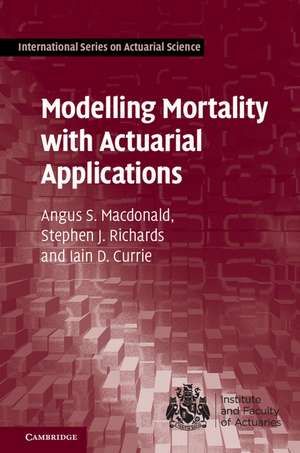Modelling Mortality with Actuarial Applications: International Series on Actuarial Science
Autor Angus S. Macdonald, Stephen J. Richards, Iain D. Currieen Limba Engleză Hardback – 2 mai 2018
Din seria International Series on Actuarial Science
- 8%
 Preț: 522.61 lei
Preț: 522.61 lei - 8%
 Preț: 572.42 lei
Preț: 572.42 lei - 8%
 Preț: 431.26 lei
Preț: 431.26 lei - 14%
 Preț: 724.77 lei
Preț: 724.77 lei - 14%
 Preț: 901.43 lei
Preț: 901.43 lei - 11%
 Preț: 487.17 lei
Preț: 487.17 lei - 14%
 Preț: 678.30 lei
Preț: 678.30 lei -
 Preț: 475.97 lei
Preț: 475.97 lei - 11%
 Preț: 458.42 lei
Preț: 458.42 lei - 11%
 Preț: 543.38 lei
Preț: 543.38 lei - 11%
 Preț: 652.53 lei
Preț: 652.53 lei - 14%
 Preț: 777.40 lei
Preț: 777.40 lei -
 Preț: 352.50 lei
Preț: 352.50 lei - 11%
 Preț: 540.91 lei
Preț: 540.91 lei - 20%
 Preț: 357.63 lei
Preț: 357.63 lei
Preț: 485.19 lei
Preț vechi: 545.16 lei
-11% Nou
Puncte Express: 728
Preț estimativ în valută:
92.84€ • 97.19$ • 76.82£
92.84€ • 97.19$ • 76.82£
Carte disponibilă
Livrare economică 15-29 martie
Preluare comenzi: 021 569.72.76
Specificații
ISBN-13: 9781107045415
ISBN-10: 110704541X
Pagini: 384
Ilustrații: 95 b/w illus. 42 tables
Dimensiuni: 158 x 235 x 20 mm
Greutate: 0.75 kg
Editura: Cambridge University Press
Colecția Cambridge University Press
Seria International Series on Actuarial Science
Locul publicării:New York, United States
ISBN-10: 110704541X
Pagini: 384
Ilustrații: 95 b/w illus. 42 tables
Dimensiuni: 158 x 235 x 20 mm
Greutate: 0.75 kg
Editura: Cambridge University Press
Colecția Cambridge University Press
Seria International Series on Actuarial Science
Locul publicării:New York, United States
Cuprins
Preface; Part I. Analysing Portfolio Mortality: 1. Introduction; 2. Data preparation; 3. The basic mathematical model; 4. Statistical inference with mortality data; 5. Fitting a parametric survival model; 6. Model comparison and tests of fit; 7. Modelling features of the portfolio; 8. Non-parametric methods; 9. Regulation; Part II. Regression and Projection Models: 10. Methods of graduation I – regression models; 11. Methods of graduation II – smooth models; 12. Methods of graduation III – 2-dimensional models; 13. Methods of graduation IV – forecasting; Part III. Multiple-State Models: 14. Markov multiple-state models; 15. Inference in the Markov model; 16. Competing risks models; 17. Counting-process models; Appendix A. R commands; Appendix B. Basic likelihood theory; Appendix C. Conversion to published tables; Appendix D. Numerical integration; Appendix E. Mean and variance-covariance of a vector; Appendix F. Differentiation with respect to a vector; Appendix G. Kronecker product of two matrices; Appendix H. R functions and programs; References; Author index; Index.
Recenzii
'This book is an excellent companion to Actuarial Mathematics for Life Contingent Risks (Dickson, Hardy and Waters) because it provides concrete applications of the theory of survival. The authors cover a lot of ground in a friendly, accessible style with real examples. Actuaries - both students and practitioners - can learn a great deal from this book.' Ian Duncan, University of California, Santa Barbara
'I taught the analysis of survival data to demographers and actuarial students for many years, and my task would have been made a great deal easier had a book like this been available. It covers the essential elements in a way that is both intellectually satisfying (starting with the fundamental concepts and building on these) and focused on the analysis of empirical data. The methods described are modern, state-of-the art approaches. Moreover, because the book provides readers with a sound understanding of the theory underlying these methods, they will be well equipped to take on board future developments, even in a fast-moving field. I can recommend this book for advanced undergraduate and Masters-level students studying actuarial science, demographic methods and related areas of statistics.' Andrew Hinde, University of Southampton
'A wonderfully comprehensive piece of work from leading experts in the field. Essential reading for anyone with an interest in longevity modelling.' Richard Willets, ReAssure Ltd.
'I taught the analysis of survival data to demographers and actuarial students for many years, and my task would have been made a great deal easier had a book like this been available. It covers the essential elements in a way that is both intellectually satisfying (starting with the fundamental concepts and building on these) and focused on the analysis of empirical data. The methods described are modern, state-of-the art approaches. Moreover, because the book provides readers with a sound understanding of the theory underlying these methods, they will be well equipped to take on board future developments, even in a fast-moving field. I can recommend this book for advanced undergraduate and Masters-level students studying actuarial science, demographic methods and related areas of statistics.' Andrew Hinde, University of Southampton
'A wonderfully comprehensive piece of work from leading experts in the field. Essential reading for anyone with an interest in longevity modelling.' Richard Willets, ReAssure Ltd.
Notă biografică
Descriere
Modern mortality modelling for actuaries and actuarial students, with example R code, to unlock the potential of individual data.
